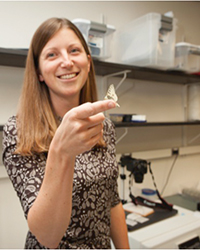
Emilie Snell-Rood (EEB) recently received nearly $500,000 from the National Science Foundation to test whether genetic differences in specialization between agricultural and nonagricultural populations are associated with differences in gene expression variability and associated reproductive tradeoffs. Read the abstract below.
Stochasticity in Gene Expression as a Mechanism Underlying Developmental Plasticity
Why are some organisms specialized, while others can survive under many conditions? This research tests the idea that patterns of gene expression in individuals are molded to specific environments through processes analogous to learning. This kind of mechanism should come with costs such as delayed breeding or fewer offspring, leading to tradeoffs associated with being a generalist. The proposed research will test these ideas using caterpillars of a crop pest species, the cabbage white butterfly. This species feeds on a wide range of plants in the mustard family, such as broccoli and canola. However, after an individual has experienced one food source, they do poorly if switched to a new food source, suggestive of a type of physiological memory. This research will test whether genetic differences in specialization between agricultural and nonagricultural populations are associated with differences in gene expression variability and associated reproductive tradeoffs. The expected results will have implications for understanding how crop pests adapt to monoculture crops, which, in many cases, may be selecting for more problematic pests. The results of this work will be communicated to the public across a number of events, including outreach fairs at the national, annual meeting of the behavior society and in association with the butterfly house at the Minnesota State Fair. Outreach modules will be developed that communicate the implications of this work for controlling agricultural pests, in addition to the importance of understanding developmental variation in the emergence of cancer.